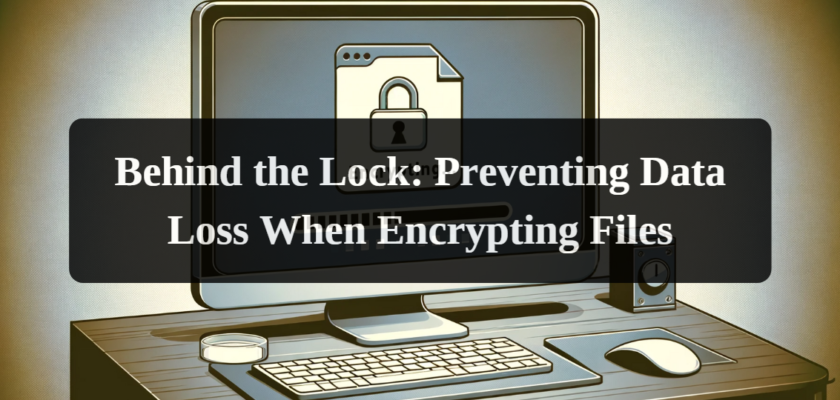Understanding File Encryption
File encryption is a critical method for securing digital data. It involves converting information into a code to prevent unauthorized access. This process is essential in an era where data breaches are common, and the implications of such breaches can be severe. There are three main types of encryption:
Encryption at Rest: This involves securing data that is stored on physical devices such as hard drives, laptops, or USB drives. The aim is to protect the data against unauthorized access if the storage device is lost or stolen.
Encryption in Transit: This type refers to the protection of data that is being transferred over a network, such as the internet or private networks. The focus is on safeguarding the data as it moves from one location to another, preventing interception or unauthorized access during transmission.
Encryption in Use: This involves encrypting data that is actively being processed or used. It’s crucial for protecting information that is being accessed or manipulated, thus reducing vulnerability to cyber-attacks or human errors during usage.
Encryption Techniques and Their Selection
Selecting the right encryption method is vital for effective data protection. The choice depends on the type of data and its usage:
Application-Level Encryption: This method involves encrypting data at the point of creation or modification within an application. It offers granular control, allowing encryption to be tailored according to user roles and permissions. For instance, a CRM system might encrypt customer data differently based on user access levels.
Database Encryption: This involves encrypting the entire database or specific portions of it. For example, a financial institution might encrypt transaction records in their entirety. This method is beneficial for large volumes of sensitive data.
File System Encryption: This type enables the encryption of specific file systems or folders within a system. It’s particularly useful for securing shared network folders, ensuring data remains encrypted and inaccessible to unauthorized users.
Public Key Infrastructure (PKI) and Steganography: PKI involves managing digital certificates and key pairs to enhance security. Steganography, on the other hand, is the technique of hiding data within other non-sensitive data, like embedding a text message within an image file. It’s often used alongside encryption for an added layer of security.
Implementing Data Loss Prevention Strategies
To minimize the risk of data loss during encryption, the following strategies are essential:
Discovery and Classification of Sensitive Data: Identify and categorize the types of data that require protection. This process involves mapping out where sensitive data resides, its importance, and how it should be handled.
Using Data Encryption Wisely: All sensitive data should be encrypted, both at rest and in transit. Techniques like EFS (Encrypting File System) in Windows can be employed to encrypt files automatically, ensuring that only authorized users can access them.
Access Control: Implement strict controls on who can access encrypted data. This includes setting up permissions and roles to ensure that only those with the necessary authorization can view or manipulate sensitive information.
Encryption Key Management and Recovery
Effective management and recovery of encryption keys are crucial for maintaining the integrity and accessibility of encrypted data. Mismanagement or loss of these keys can result in permanent data loss.
Key Management: This involves the secure creation, storage, distribution, and destruction of encryption keys. Best practices include using secure key management systems that restrict access to authorized users and regularly updating and rotating keys to reduce the risk of compromise.
Key Recovery: It’s essential to have a robust key recovery process. This should include regular backups of keys, preferably in separate and secure locations. In case of key loss or corruption, these backups can be used to restore access to encrypted data.
Regular Audits and Compliance: Conducting regular audits of key management practices helps ensure compliance with data security standards and identifies any potential vulnerabilities in the key management process.
Understanding Decryption: When and How
Decryption is the process of converting encrypted data back into its original form. However, successful decryption depends on various factors.
Availability of Correct Keys: Decryption is typically possible when the correct encryption keys are available. Without these keys, accessing the original data can be challenging or impossible.
Correct Decryption Methods: The decryption process must match the encryption method used. Using an incorrect method or algorithm can result in failure to decrypt the data properly.
Situations of Irreversible Encryption: In cases where encryption methods are designed to be irreversible or where keys are permanently lost or corrupted, decryption becomes impossible. It’s crucial to understand and plan for these scenarios during the encryption process.
The Role of Cybersecurity Education
Cybersecurity education is a critical component in safeguarding data during the encryption and decryption processes. Educating staff about cybersecurity best practices reduces the risk of human error, which is a significant factor in data breaches.
Awareness Training: Regular training sessions should be conducted to keep employees informed about the latest cybersecurity threats and safe data handling practices.
Best Practice Guidelines: Develop clear guidelines for handling sensitive data, including the correct use of encryption and decryption processes.
Simulated Cybersecurity Exercises: Conducting mock drills or simulated attacks can help staff understand the practical implications of a data breach and the importance of following security protocols.
Seeking Professional Help for Decryption
There are instances where decryption attempts may fail due to complex encryption algorithms or lost keys. In such situations, seeking professional help is advisable.
Expert Consultation: Professionals specializing in data encryption and decryption can provide valuable insights and solutions when in-house efforts fail.
Advanced Decryption Tools: Cybersecurity firms often have access to advanced tools and technologies that can aid in decrypting data without compromising its integrity.
Conclusion
To effectively avoid data loss during file encryption, it’s essential to understand and implement robust encryption techniques, ensure effective key management, comprehend the limitations of decryption, and educate staff on cybersecurity best practices. By adhering to these guidelines, organizations can significantly enhance the security and integrity of their sensitive data

